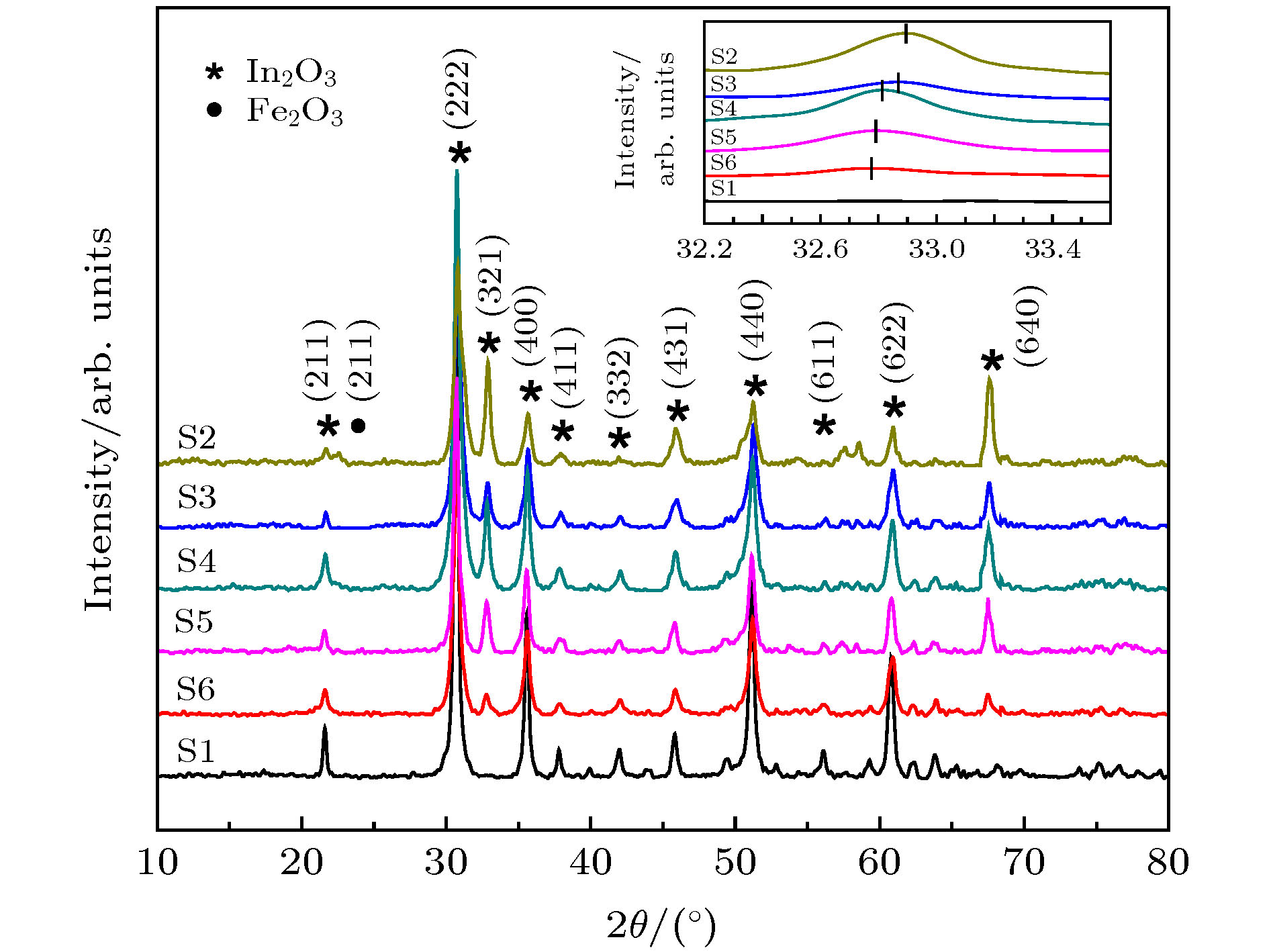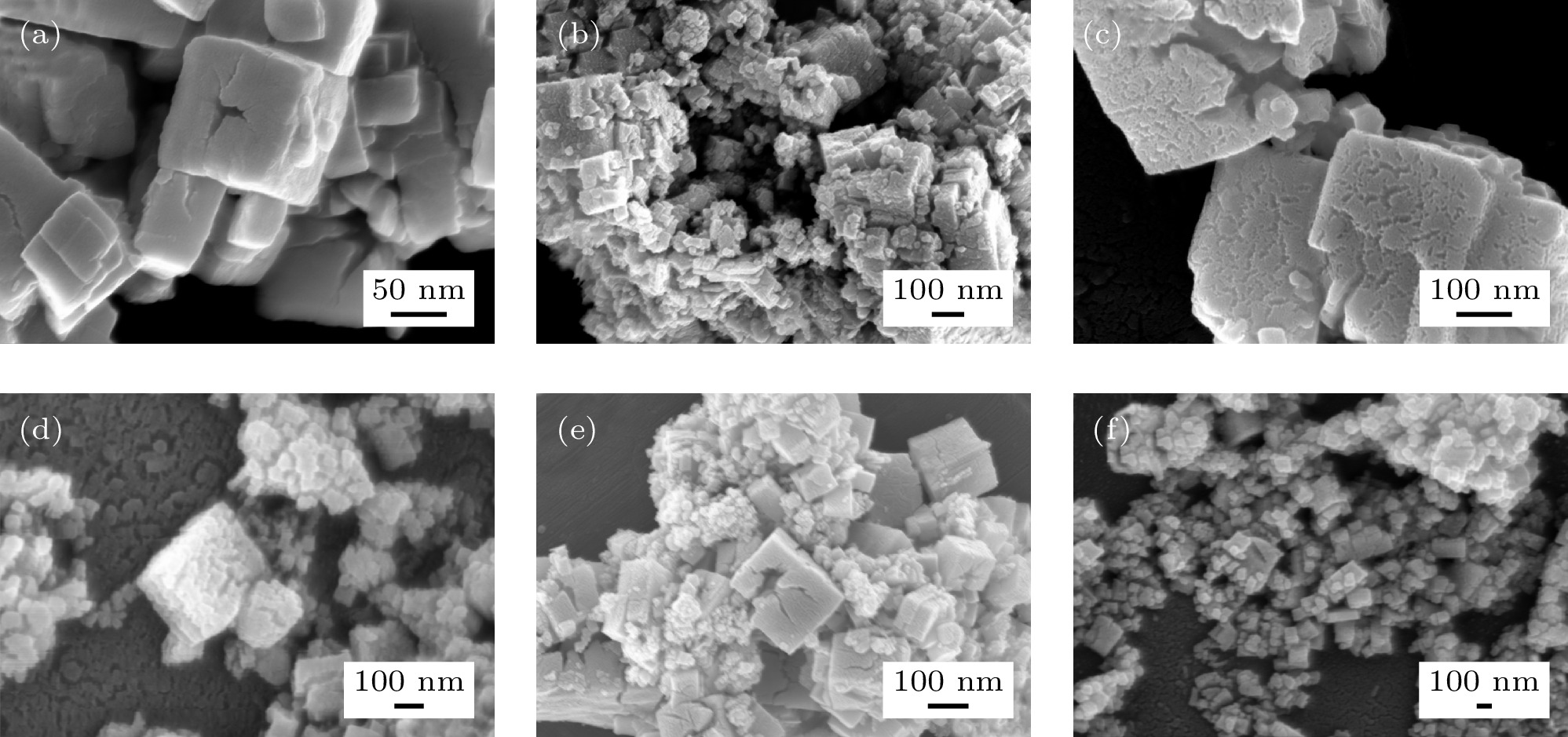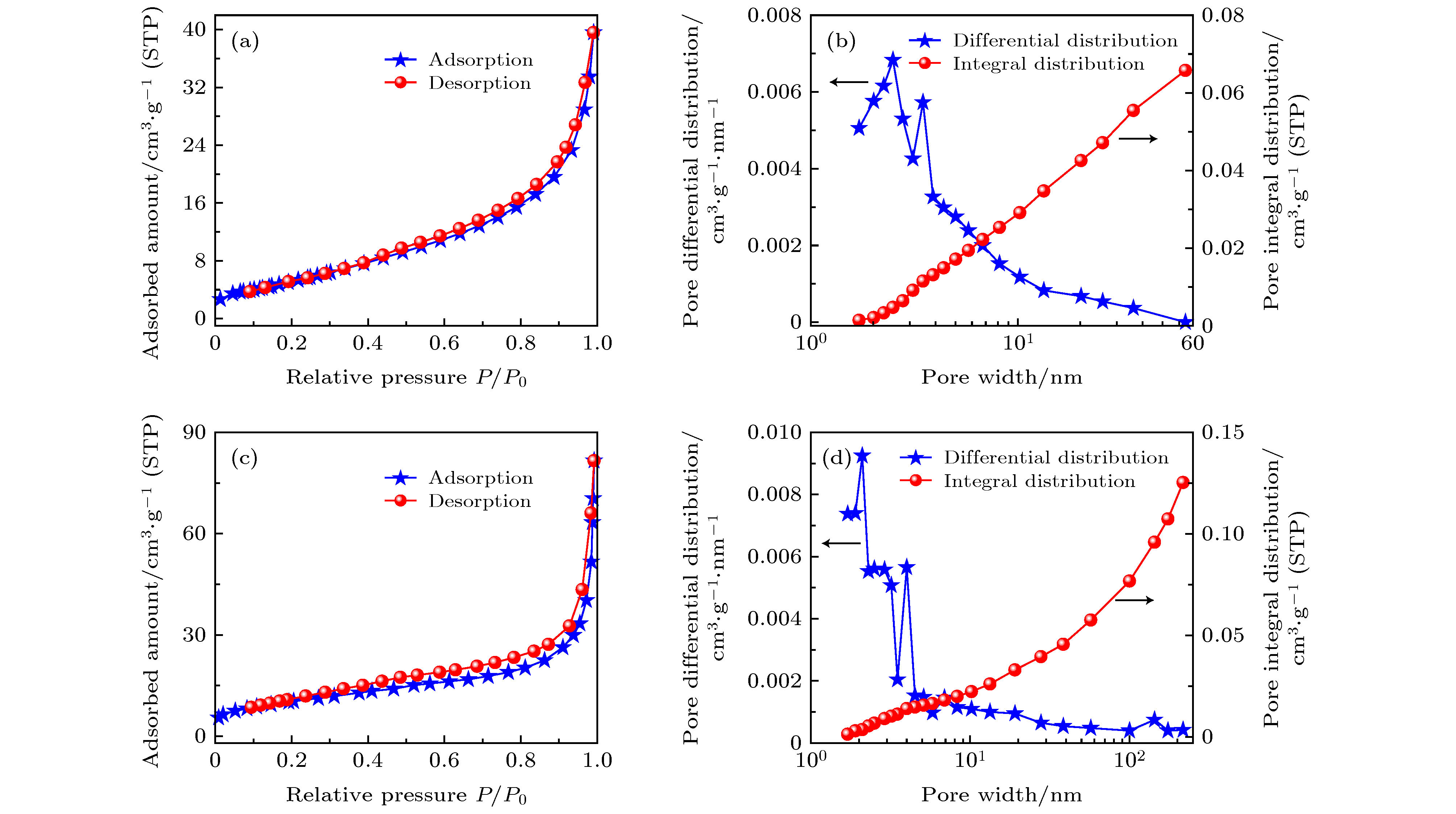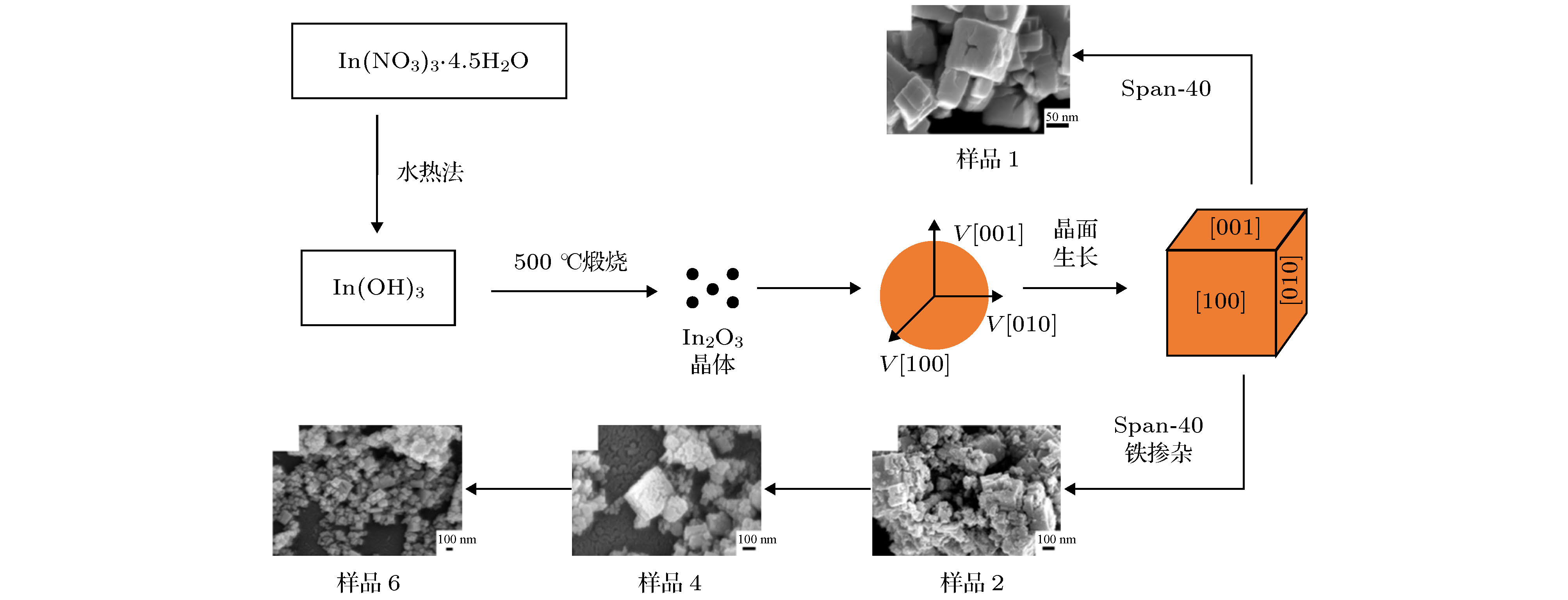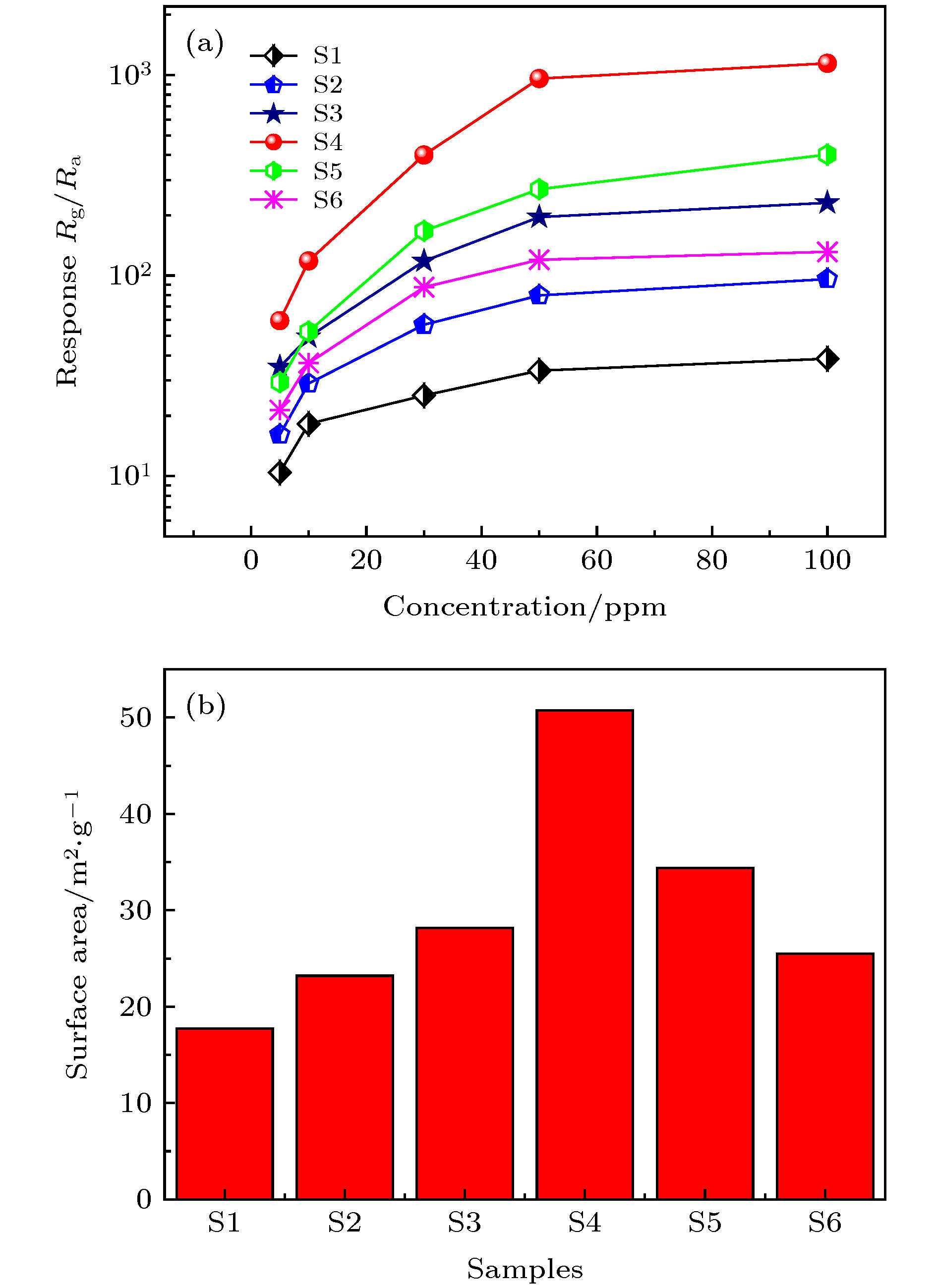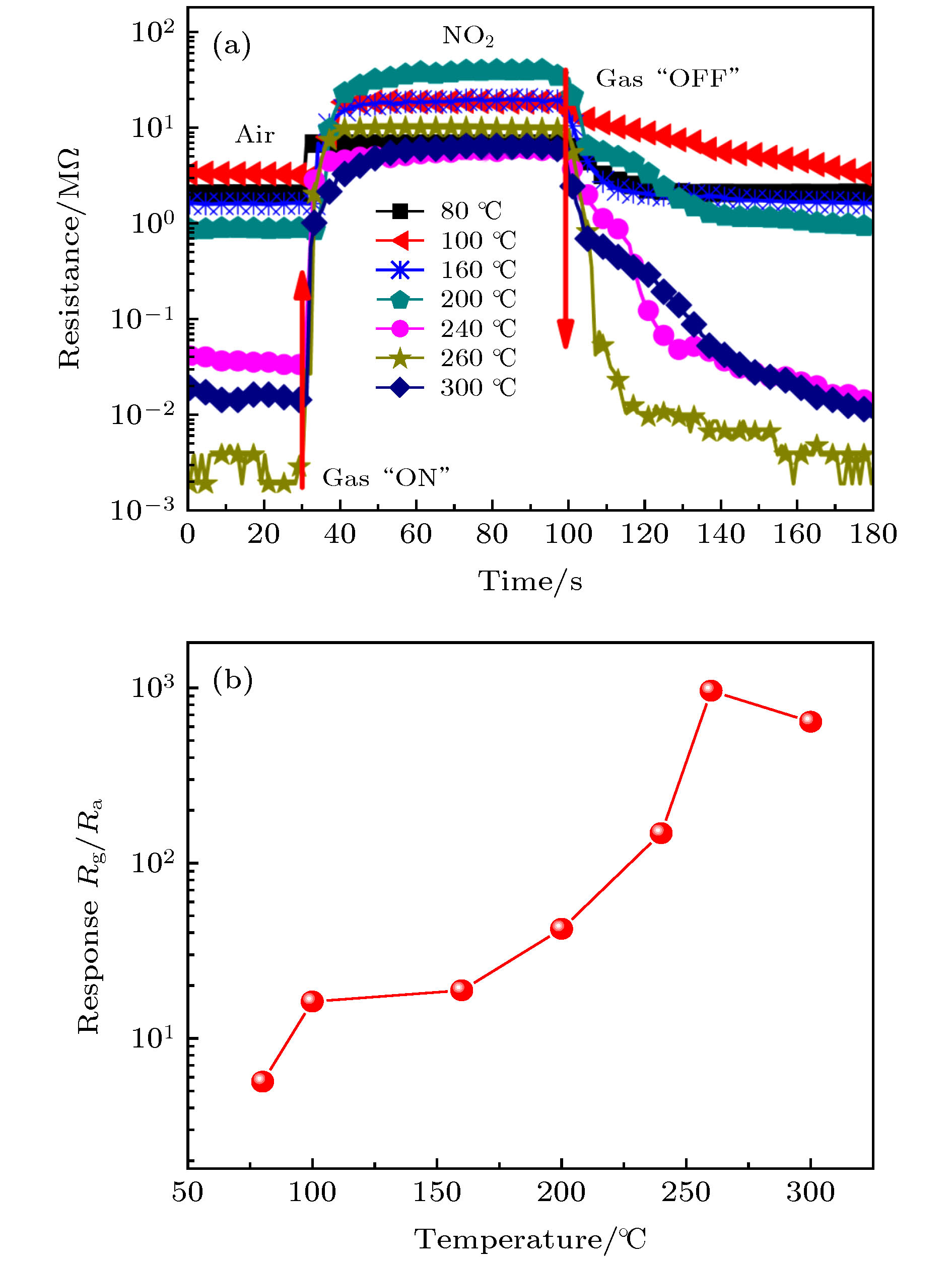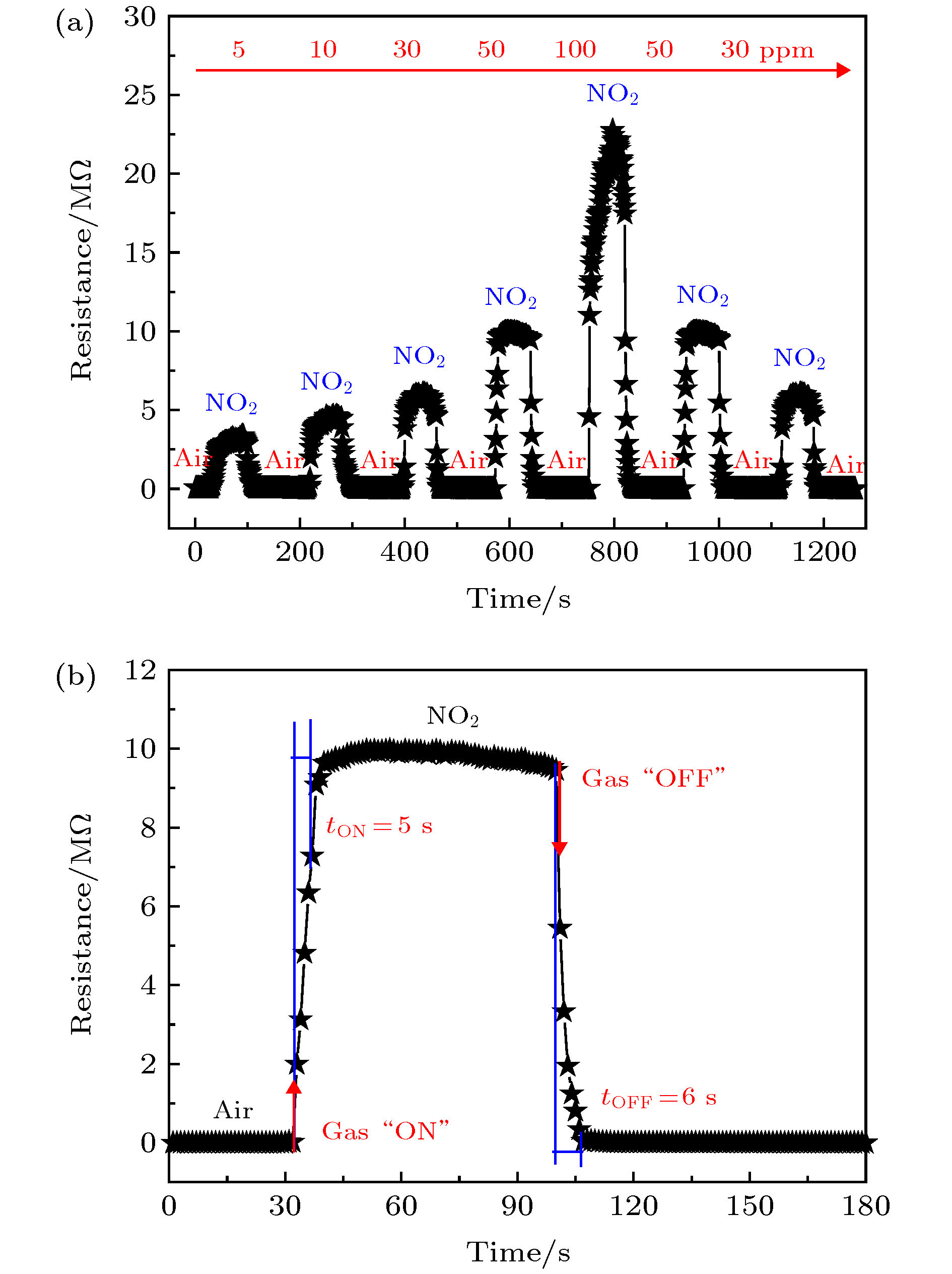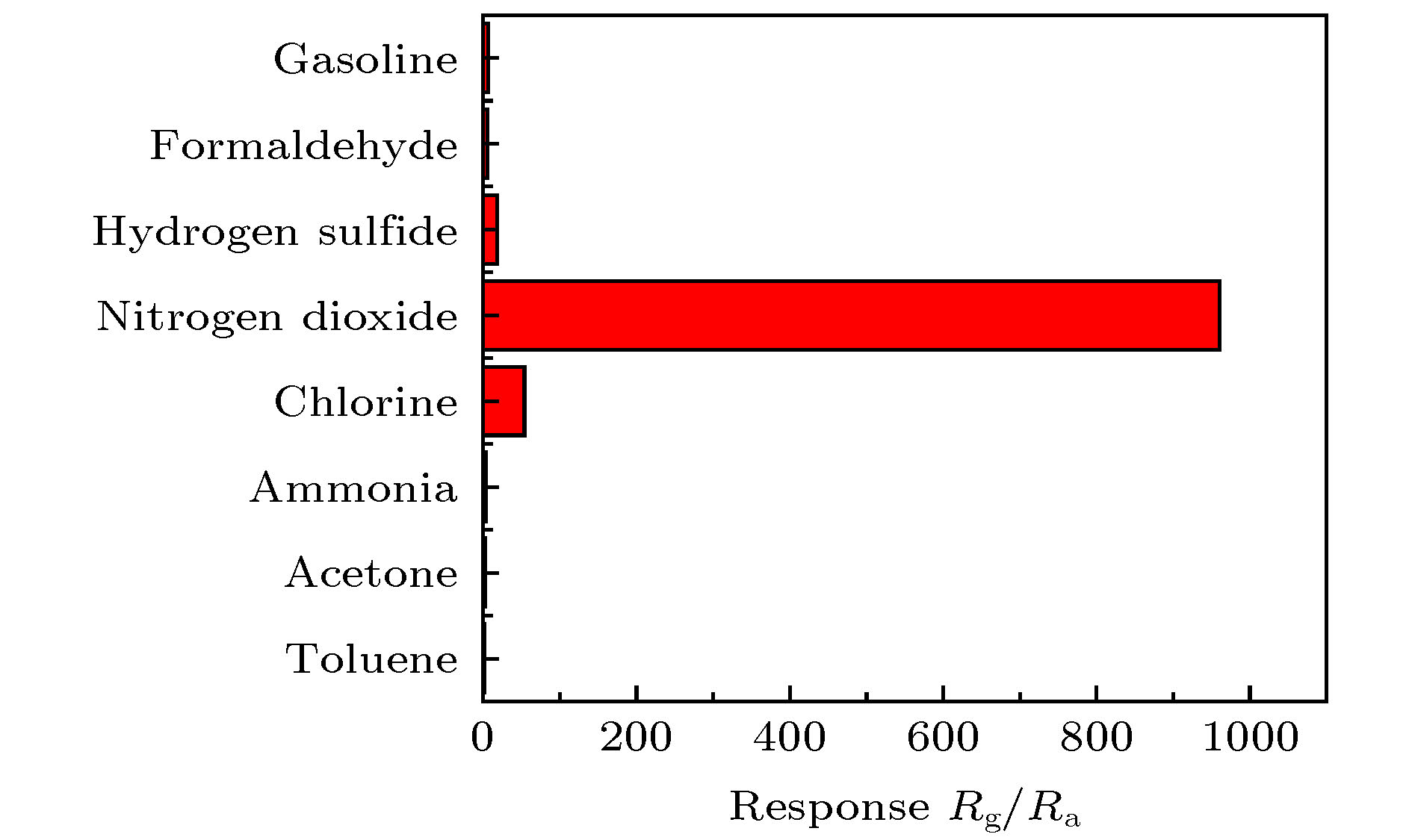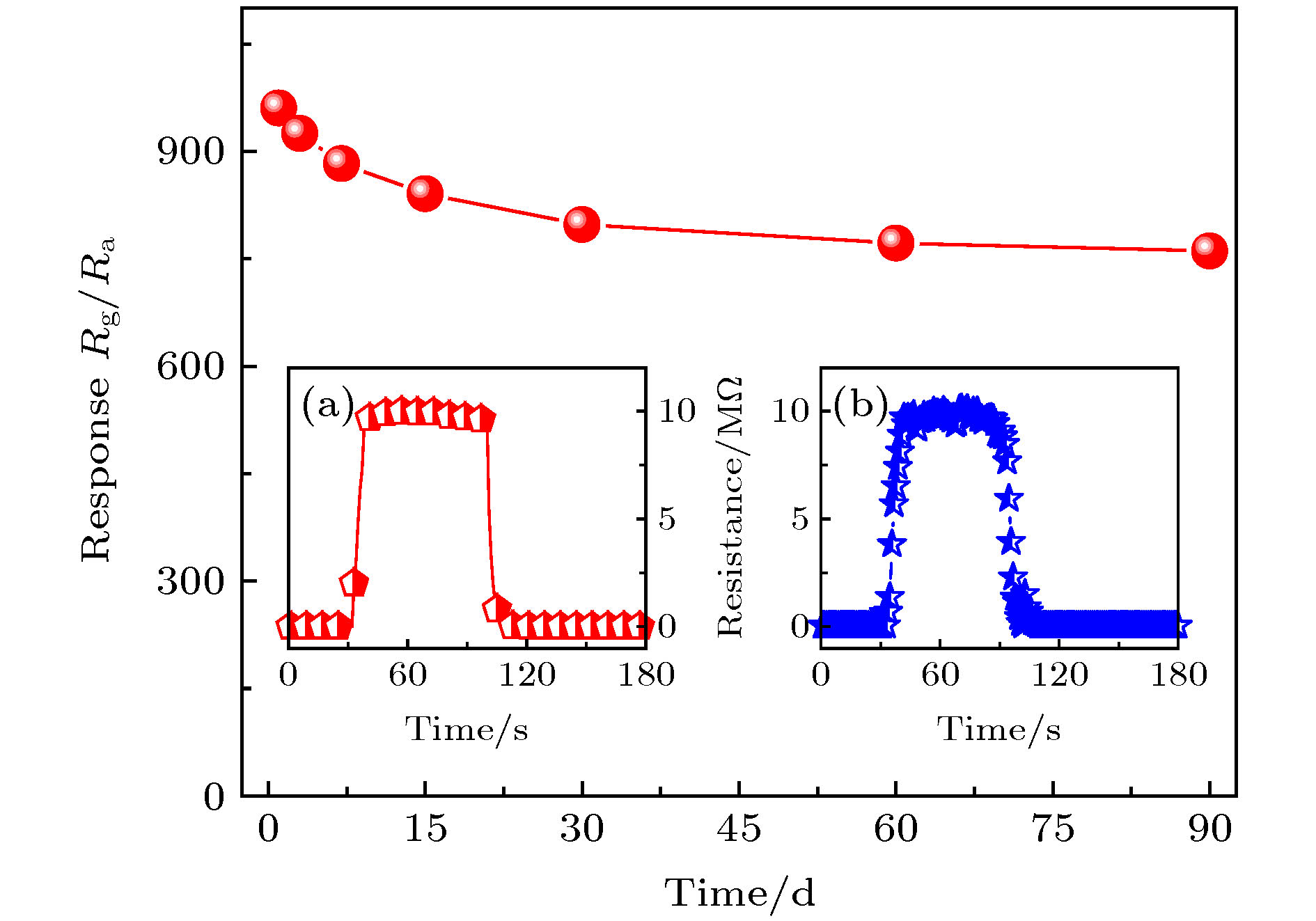-
研究NO2传感器材料特性和工作机理, 对监测大气污染及人体健康保护有重要意义. 本文采用水热法合成了铁掺杂的多孔In2O3纳米颗粒, 并基于上述纳米颗粒制备了NO2传感器. 运用X射线衍射仪、扫描电子显微镜、透射电子显微镜和比表面积测试对所制备的纳米颗粒进行微观形貌表征, 同时对传感器性能包括温度特性、响应-恢复特性、选择性和稳定性等进行研究. 研究发现, 当In和Fe摩尔比为9∶1时, 由铁掺杂多孔In2O3纳米颗粒制作的传感器对NO2气体具有优秀的选择性和较短的响应-恢复时间. 在260 ℃的工作温度下, 传感器对浓度为50 ppm (1 ppm = 1 mg/L)的NO2气体的灵敏度值为960.5, 响应时间和恢复时间分别为5和6 s. 形貌测试结果表明, 采用Span-40做活性剂制备的铁掺杂In2O3纳米颗粒为边长50—200 nm的方形结构, 其中分布大量细小孔洞, 这是导致大的比表面积和高灵敏度的主要原因之一. 同时, 从空间电荷、内建势垒和掺杂前后能带变化等理论出发, 对所制备传感器的传感机理进行了分析.It is of great significance to study the characteristics and working mechanism of NO2 sensor material for monitoring air pollution and protecting human health. As a metal oxide semiconductor material with simple preparation, low cost and good long-term stability, In2O3 has been widely studied in the detection of NO2. In order to explore the influence of Fe content on the gas sensing properties of porous In2O3 material, porous Fe-doped In2O3 nanoparticles are synthesized by the hydrothermal method, and the NO2 sensor is fabricated by using the above nanoparticles. The X-ray diffraction (XRD), scanning electron microscopy (SEM), transmission electron microscopy and specific surface area measurement are used to characterize the micro morphology of the prepared nanoparticles in this paper, while the sensor performance is studied, including temperature, response recovery, selectivity and stability. In most samples, Fe atoms are completely doped into the In2O3 lattice as indicated by the XRD results. The SEM results show that the Fe-doped In2O3 nanoparticles prepared with Span-40 as activators are square in size of 50–200 nm, and a large number of small pores are distributed in it, which are also observed in the N2 adsorption/desorption experiment, this is one of the main reasons for the large specific surface area and high sensitivity of the nano materials. Studying the performance of the sensor, we find that when the molar ratio of In∶Fe is 9∶1, the sensor made of porous Fe-doped In2O3 nanoparticles has an excellent selectivity and short response recovery time for NO2 gas. The sensitivity of the sensor to 50-ppm-concentration (1 ppm = 1 mg/L) NO2 can reach 960.5 at 260 ℃, and the response time and recovery time are 5 s and 6 s respectively. Based on the theory of space charge and the knowledge of built-in barrier and energy band change before and after doping, the mechanism of the sensor is analyzed.
-
Keywords:
- Fe-doped In2O3 /
- porous /
- NO2 /
- sensor
[1] Xu X M, Zhang H J, Diao Q, Zhu Y S, Yang G 2019 Mater. Res. Express 6 17
 Google Scholar
Google Scholar
[2] Bo Z, Guo X Z, Wei X, Yang H C, Yan J H, Cen K F 2019 Physica E 109 156
 Google Scholar
Google Scholar
[3] Borgohain R, Das R, Mondal B, Yordsri V, Thanachayanont C, Baruah S 2018 IEEE Sens. J. 18 7203
 Google Scholar
Google Scholar
[4] 赵博硕, 强晓永, 秦岳, 胡明 2018 物理学报 67 058101
 Google Scholar
Google Scholar
Zhao B S, Qiang X Y, Qin Y, Hu M 2018 Acta Phys. Sin. 67 058101
 Google Scholar
Google Scholar
[5] Zhou P F, Shen Y B, Lu W, Zhao S K, Li T T, Zhong X X, Cui B Y, Wei D Z, Zhang Y H 2020 J. Alloys Compd. 828 154395
 Google Scholar
Google Scholar
[6] Hung N M, Hieu N M, Chinh N D, Hien T T, Quang N D, Majumder S, Choi G, Kim C, Kim D 2020 Sens. Actuators, B 313 128001
 Google Scholar
Google Scholar
[7] Chen K X, Lu H, Li G, Zhang J N, Tian Y H, Gao Y, Guo Q M, Lu H B, Gao J Z 2020 Sens. Actuator, B 308 127716
 Google Scholar
Google Scholar
[8] Nam B, Ko T K, Hyun S K, Lee C 2019 Nano Converg. 6 40
 Google Scholar
Google Scholar
[9] Shen Y B, Zhong X X, Zhang J, Li T T, Zhao S K, Cui B Y, Wei D Z, Zhang Y H, Wei K F 2019 Appl. Surf. Sci. 498 143873
 Google Scholar
Google Scholar
[10] Pawar K K, Shaikh J S, Mali S S, Navale Y H, Patil V B, Hong C K, Patil P S 2019 J. Alloys Compd. 806 726
 Google Scholar
Google Scholar
[11] Yang W, Chen H T, Li C L, Meng H 2020 Mater. Lett. 271 127782
 Google Scholar
Google Scholar
[12] Park B G, Reddeppa M, Kim Y H, Kim S G, Kim M D 2020 Nanotechnology 31 335503
 Google Scholar
Google Scholar
[13] Zhao S K, Shen Y B, Zhou P F, Hao F L, Xu X Y, Gao S L, Wei D Z, Ao Y X, Shen Y S 2020 Sens. Actuator, B 308 127729
 Google Scholar
Google Scholar
[14] Bi H S, Shen Y B, Zhao S K, Zhou P F, Gao S L, Cui B Y, Wei D Z, Zhang Y H, Wei K F 2020 Vacuum 172 109086
 Google Scholar
Google Scholar
[15] Cheng M, Wu Z P, Liu G N, Zhao L J, Gao Y, Li S, Zhang B, Yan X, Lu G Y 2020 Sens. Actuator, B 304 127272
 Google Scholar
Google Scholar
[16] Ri J S, Li X W, Shao C L, Liu Y, Han C H, Li X H, Liu Y C 2020 Sens. Actuator, B 317 128194
 Google Scholar
Google Scholar
[17] Sabry R S, Agool I R, Abbas A M 2019 Silicon 11 2475
 Google Scholar
Google Scholar
[18] Lee O H, Tseng W J 2019 J. Mater. Sci.-Mater. Electron. 30 15145
 Google Scholar
Google Scholar
[19] Inyawilert K, Channei D, Tamaekong N, Liewhiran C, Wisitsoraat A, Tuantranont A, Phanichphant S 2016 J. Nanopart. Res. 18 40
 Google Scholar
Google Scholar
[20] Yoo Y K, Xue Q Z, Lee H C, Cheng S F, Xiang X D, Dionne G F, Xu S F, He J, Chu Y S, Preite S D, Lofland S E, Takeuchi I 2005 Appl. Phys. Lett. 86 042506
 Google Scholar
Google Scholar
[21] Sreethawong T, Chavadej S, Ngamsinlapasathian S, Yoshikawa S 2008 Microporous Mesoporous Mater. 109 84
 Google Scholar
Google Scholar
[22] Cao M H, Wang Y D, Chen T, Antonietti M, Niederberger M 2008 Chem. Mater. 20 5781
 Google Scholar
Google Scholar
[23] Jia X, Fan H 2010 Mater. Res. Bull. 45 1496
 Google Scholar
Google Scholar
[24] Wetchakun K, Samerjai T, Tamaekong N, Liewhiran C, Siriwong V, Kruefu V, Wisitsoraat A, Tuantranont A, Phanichphant S 2011 Sens. Actuator, B 160 580
 Google Scholar
Google Scholar
[25] Bai S L, Zhang K W, Luo R X, Li D Q, Chen A F, Liu C C 2012 J. Mater. Chem. 22 12643
 Google Scholar
Google Scholar
[26] Xiao B X, Zhao Q, Wang D X, Ma G S, Zhang M Z 2017 New J. Chem. 41 8530
 Google Scholar
Google Scholar
[27] Zhao J, Yang T L, Liu Y P, Wang Z Y, Li X W, Sun Y F, Du Y, Li Y C, Lu G Y 2014 Sens. Actuator, B 191 806
 Google Scholar
Google Scholar
[28] Han D M, Zhai L L, Gu F B, Wang Z H 2018 Sens. Actuator, B 262 655
 Google Scholar
Google Scholar
[29] Hu J, Liang Y F, Sun Y J, Zhao Z T, Zhang M, Li P W, Zhang W D, Chen Y, Zhuiykov S 2017 Sens. Actuator, B 252 116
 Google Scholar
Google Scholar
[30] Fahed C, Qadri S B, Kim H, Piqué A, Miller M, Mahadik N A, Rao M V, Osofsky M 2010 Phys. Status Solidi C 7 2298
 Google Scholar
Google Scholar
-
表 1 样品原材料组成表
Table 1. Composition of sample raw materials.
样品编号 组成及用量/g In/Fe摩尔比 In(NO3)3·4.5H2O Fe(NO3)3·9H2O Span-40 样品1 (S1) 0.5729 0 0.6030 — 样品2 (S2) 0.5729 0.1212 0.6030 5∶1 样品3 (S3) 0.5729 0.0866 0.6030 7∶1 样品4 (S4) 0.5729 0.0673 0.6030 9∶1 样品5 (S5) 0.5729 0.0505 0.6030 12∶1 样品6 (S6) 0.5729 0.0404 0.6030 15∶1 -
[1] Xu X M, Zhang H J, Diao Q, Zhu Y S, Yang G 2019 Mater. Res. Express 6 17
 Google Scholar
Google Scholar
[2] Bo Z, Guo X Z, Wei X, Yang H C, Yan J H, Cen K F 2019 Physica E 109 156
 Google Scholar
Google Scholar
[3] Borgohain R, Das R, Mondal B, Yordsri V, Thanachayanont C, Baruah S 2018 IEEE Sens. J. 18 7203
 Google Scholar
Google Scholar
[4] 赵博硕, 强晓永, 秦岳, 胡明 2018 物理学报 67 058101
 Google Scholar
Google Scholar
Zhao B S, Qiang X Y, Qin Y, Hu M 2018 Acta Phys. Sin. 67 058101
 Google Scholar
Google Scholar
[5] Zhou P F, Shen Y B, Lu W, Zhao S K, Li T T, Zhong X X, Cui B Y, Wei D Z, Zhang Y H 2020 J. Alloys Compd. 828 154395
 Google Scholar
Google Scholar
[6] Hung N M, Hieu N M, Chinh N D, Hien T T, Quang N D, Majumder S, Choi G, Kim C, Kim D 2020 Sens. Actuators, B 313 128001
 Google Scholar
Google Scholar
[7] Chen K X, Lu H, Li G, Zhang J N, Tian Y H, Gao Y, Guo Q M, Lu H B, Gao J Z 2020 Sens. Actuator, B 308 127716
 Google Scholar
Google Scholar
[8] Nam B, Ko T K, Hyun S K, Lee C 2019 Nano Converg. 6 40
 Google Scholar
Google Scholar
[9] Shen Y B, Zhong X X, Zhang J, Li T T, Zhao S K, Cui B Y, Wei D Z, Zhang Y H, Wei K F 2019 Appl. Surf. Sci. 498 143873
 Google Scholar
Google Scholar
[10] Pawar K K, Shaikh J S, Mali S S, Navale Y H, Patil V B, Hong C K, Patil P S 2019 J. Alloys Compd. 806 726
 Google Scholar
Google Scholar
[11] Yang W, Chen H T, Li C L, Meng H 2020 Mater. Lett. 271 127782
 Google Scholar
Google Scholar
[12] Park B G, Reddeppa M, Kim Y H, Kim S G, Kim M D 2020 Nanotechnology 31 335503
 Google Scholar
Google Scholar
[13] Zhao S K, Shen Y B, Zhou P F, Hao F L, Xu X Y, Gao S L, Wei D Z, Ao Y X, Shen Y S 2020 Sens. Actuator, B 308 127729
 Google Scholar
Google Scholar
[14] Bi H S, Shen Y B, Zhao S K, Zhou P F, Gao S L, Cui B Y, Wei D Z, Zhang Y H, Wei K F 2020 Vacuum 172 109086
 Google Scholar
Google Scholar
[15] Cheng M, Wu Z P, Liu G N, Zhao L J, Gao Y, Li S, Zhang B, Yan X, Lu G Y 2020 Sens. Actuator, B 304 127272
 Google Scholar
Google Scholar
[16] Ri J S, Li X W, Shao C L, Liu Y, Han C H, Li X H, Liu Y C 2020 Sens. Actuator, B 317 128194
 Google Scholar
Google Scholar
[17] Sabry R S, Agool I R, Abbas A M 2019 Silicon 11 2475
 Google Scholar
Google Scholar
[18] Lee O H, Tseng W J 2019 J. Mater. Sci.-Mater. Electron. 30 15145
 Google Scholar
Google Scholar
[19] Inyawilert K, Channei D, Tamaekong N, Liewhiran C, Wisitsoraat A, Tuantranont A, Phanichphant S 2016 J. Nanopart. Res. 18 40
 Google Scholar
Google Scholar
[20] Yoo Y K, Xue Q Z, Lee H C, Cheng S F, Xiang X D, Dionne G F, Xu S F, He J, Chu Y S, Preite S D, Lofland S E, Takeuchi I 2005 Appl. Phys. Lett. 86 042506
 Google Scholar
Google Scholar
[21] Sreethawong T, Chavadej S, Ngamsinlapasathian S, Yoshikawa S 2008 Microporous Mesoporous Mater. 109 84
 Google Scholar
Google Scholar
[22] Cao M H, Wang Y D, Chen T, Antonietti M, Niederberger M 2008 Chem. Mater. 20 5781
 Google Scholar
Google Scholar
[23] Jia X, Fan H 2010 Mater. Res. Bull. 45 1496
 Google Scholar
Google Scholar
[24] Wetchakun K, Samerjai T, Tamaekong N, Liewhiran C, Siriwong V, Kruefu V, Wisitsoraat A, Tuantranont A, Phanichphant S 2011 Sens. Actuator, B 160 580
 Google Scholar
Google Scholar
[25] Bai S L, Zhang K W, Luo R X, Li D Q, Chen A F, Liu C C 2012 J. Mater. Chem. 22 12643
 Google Scholar
Google Scholar
[26] Xiao B X, Zhao Q, Wang D X, Ma G S, Zhang M Z 2017 New J. Chem. 41 8530
 Google Scholar
Google Scholar
[27] Zhao J, Yang T L, Liu Y P, Wang Z Y, Li X W, Sun Y F, Du Y, Li Y C, Lu G Y 2014 Sens. Actuator, B 191 806
 Google Scholar
Google Scholar
[28] Han D M, Zhai L L, Gu F B, Wang Z H 2018 Sens. Actuator, B 262 655
 Google Scholar
Google Scholar
[29] Hu J, Liang Y F, Sun Y J, Zhao Z T, Zhang M, Li P W, Zhang W D, Chen Y, Zhuiykov S 2017 Sens. Actuator, B 252 116
 Google Scholar
Google Scholar
[30] Fahed C, Qadri S B, Kim H, Piqué A, Miller M, Mahadik N A, Rao M V, Osofsky M 2010 Phys. Status Solidi C 7 2298
 Google Scholar
Google Scholar
计量
- 文章访问数: 7334
- PDF下载量: 86
- 被引次数: 0














 下载:
下载:
